Final report for LNE20-402
Project Information
Production of greens during winter is limited by three major factors: low-yielding production practices, poor stand associated with damping-off, and reduced yields caused by emerging diseases, especially downy mildew (DM), which can cause 100% loss. This project sought to mitigate these factors and increase profitability of Northeast winter spinach production by providing education about production practices and emerging diseases and conducting applied research trials to determine optimal production practices specific to Northeast high tunnel spinach growers.
We conducted two variety trials to assess the productivity of DM-resistant spinach varieties under Northeast winter growing conditions, and an additional trial to evaluate the impacts of seed priming, the use of green manures, and spinach varieties on germination, stand, and yield. We also conducted three on-farm case studies on profitability of different spinach production systems to provide a foundation for education on improving production and yield of winter spinach, and provided consultations and diagnostic support for growers that had DM outbreaks on their farms. The results of this research and case studies were disseminated through two webinars, two conference presentations, and an in-person field day, as well as through two fact sheets, four newsletter articles, and a fillable enterprise budget workbook. From these outputs, 100 farmers and 25 agricultural service providers reported increases in knowledge regarding winter spinach production methods, DM pathology and management, variety selection, and the economics of winter spinach.
Our research showed that many spinach varieties are acceptable for New England winter production. The top 10 performers in more than one year of trials were: Colusa, Nevada, Cocopah, Nembus, and Kiowa. Varieties that had high quality regrowth included but aren’t limited to: Crosstrek, Patton, Kiowa, Responder, and Colusa. In our spinach germination and stand trial, plots with buckwheat incorporated significantly outperformed those with no buckwheat – but the mechanism behind those effects are unknown. More research is needed to investigate whether the benefits we saw from buckwheat incorporation were from the addition of fresh organic matter to the soil, the nitrogen that the buckwheat contributed to the soil, or both.
212 farmers adopted spinach production practices that we recommended. In a survey of high tunnel spinach outreach participants, 192 growers reported increases of profitability. From this survey, we measured that profits from winter spinach production for these growers combined increased by at least $148,442.
125 Northeast growers adopt at least one new best management practice in a total of 250 high tunnels. These farmers report an average yield of 0.5 lb/sq ft, and increased off-season revenue totaling $525,000 annually.
Problem and Justification: Consumer demand for fresh, local greens in winter is limitless, and production is not nearly meeting demand, representing a huge opportunity to increase financial sustainability of individual farms and sustainability of our Northeast regional food system. Production of greens during winter is limited by three major factors: low-yielding production practices, poor stand associated with damping-off, and reduced yields caused by emerging diseases, especially downy mildews, which can cause 100% losses.
Downy mildews (DM) can be managed effectively by planting resistant varieties, but a gap in knowledge exists among growers and seed representatives, and the best varieties with broad DM-resistance are not being planted in the Northeast. Furthermore, intensive year-round production in high-tunnels leads to poor soil health and increased pressure from soil-borne diseases, especially damping-off, causing poor stand. Finally, growers could increase yields by increasing planting density, planting higher-yielding varieties, using more efficient irrigation and fertility practices, or modifying harvest systems.
Over 2,000 organic and conventional greens growers and agricultural service providers across the Northeast could benefit from education about emerging diseases, and more modern production systems. Other benefits include: generating off-season revenue, maintaining farming jobs and customer relationships over the off-season, lowering financial risk by increasing crop diversity, and improving soil health in high-tunnels.
Solution and Approach: On-farm surveys of current production practices and on-farm case studies on profitability of different production systems conducted for this project provided a foundation for education on improving production and yield of winter greens. Connecting with technical advisers in major greens production areas brought expertise about complicated diseases and knowledge about modern techniques to our region. Research was conducted to assess productivity of DM-resistant varieties under Northeast winter growing conditions, impacts of seed priming on germination and stand, and use of green manures to increase soil microbial health, reducing soil-borne disease and increasing crop establishment and yield.
Milestones and Performance Target:
- 2,800 growers and agricultural service providers learned about project activities and increased knowledge on winter greens production and profitability, current status of DM across the region, and disease management using resistant varieties
- 284 growers and agricultural service providers attended or viewed webinars to increase knowledge on CA production practices, DM biology and management, and use of resistant varieties
- 159 growers attended workshops and field days and increased knowledge of cost-effective production methods
- 16 growers who attended educational programs expressed interest in improving their winter greens production efficiency and received follow-up from project team
- 6 growers planted a resistant variety or adopted another improved winter-greens production practice (e.g. increased plant density, more efficient harvest methods, etc.)
- Our end-of-project survey indicated that 85% of participants (212 growers) adopted at least one new or improved practice, and improved their yield. 77% (192 growers) reported that adopting these practices increased their profits. 38% (95 growers) reported achieving yields of approximately 0.5 lbs/sq ft, and 19% (47 growers) reported achieving yields above 0.5 lbs/sq ft. With the profit ranges provided in the survey, we measured that profits from winter spinach production for these growers combined increased by more than $148,442.
Cooperators
- (Educator and Researcher)
- (Educator and Researcher)
Research
Profitability of winter greens production is directly related to plant establishment and disease prevention. Our research program is aimed at increasing yield by improving germination, increasing planting density, and reducing disease including damping-off and downy mildews. Replicated on-farm trials will address the following hypotheses:
- New varieties offer improved resistance to disease and improved growth under winter growing conditions.
- Increasing active soil organic matter can reduce damping-off and increase plant stand
- Increasing germination by priming seed before planting can increase plant stand
- Increasing plant density up to 4 million seeds/A can lead to increased yield
All experiments will be conducted at the UMass Crop and Animal Research and Education Farm in South Deerfield, MA, in an existing 30x96’ Rimol high tunnel. Soil will be prepared and fertilizers added based on soil test results in late-September and treatments will be planted in October. Spinach will be irrigated and side-dressed as needed according to soil moisture probes checked weekly and pre-sidedress nitrate tests taken monthly.
1. Variety trials, winter 2020-21: In fall 2020, a spinach variety trial was set up to test this hypothesis at the UMass Crop & Livestock Research & Education Farm in South Deerfield, MA. This trial was managed by G. Higgins of UMass.
- Treatments: 18 spinach varieties were chosen for evaluation, taking into consideration recommendations by seed production and distribution company representatives. Varieties were chosen for their downy mildew resistance and for their growth speed under winter tunnel conditions.
- Methods: All varieties were seeded on October 18, 2020, at a rate of 3 million seeds/A, with 4 replications of each variety in a randomized complete block design. Plots were 2'x4' and there was 1' between plots in-bed. Pre-sidedress nitrate tests were taken monthly and indicated that the spinach should be sidedressed in late February - because the trial was almost complete at that point, no additional fertilizer was added. Downy mildew was not found in this trial.
- Data Collection and Analysis: Germination, stand, vigor, and disease severity (%) were assessed weekly October 21-March 30, and marketable yield was evaluated 6 times throughout the winter, with each variety being harvested 2-4 times between December 22 and March 30. All data were analyzed using a general linear model and means were compared using Tukey’s honestly significant difference test (P = 0.05) in SAS.
-

Spinach high tunnel variety trial at the UMass Research Farm, before the first harvest. December 8, 2020. 
Harvesting spinach from the high tunnel variety trial. December 22, 2020.
2. Variety trial, 2021-22: We did not undertake a full variety trial for winter 2021-22 but instead incorporated the evaluation of 2 spinach varieties into the winter 2021-22 germination/stand trial.
3. Improving plant stand, winter 2021-22: In fall 2021, a trial to evaluate the effects of seed priming, spinach cultivar, and incorporation of buckwheat cover crop on spinach stand was set up at the UMass Crop & Livestock Research & Education Farm in South Deerfield, MA. This trial is being managed by G. Higgins of UMass.
- Treatments: The impact of cover crop residue as a pre-plant soil amendment on seedling emergence and suppression of damping off caused by Rhizoctonia solani, Pythium spp., and Phythophthora spp. is being evaluated compared to an untreated control and a compost-amended soil. The effect of seed priming is being evaluated as a split-plot factor in this full factorial design, and half the seed was primed before planting and the other half was planted without priming.
- Two spinach cultivars were chosen for evaluation as well - Kolibri is a cultivar commonly grown in winter high tunnels in the Northeast, and Crosstrek is a newer variety that performed well in the spinach variety trial conducted under this grant over winter 2020-21.
- Methods: Buckwheat was seeded into half of the tunnel on July 30, at a rate of 90 lbs/A. The buckwheat residue was incorporated on September 10, three weeks before seeding spinach into the tunnel. The spinach seed was primed on September 30 - the seed was soaked in 0.3% hydrogen peroxide solution for 3 hours, then drained and placed in an airtight container for 16 hours at approximately 65F. Spinach was seeded into the tunnel on September 31, at a rate of 3 million seeds/A (70 seeds/sq ft). Plots were 2'x6', with 1' between plots in-bed, and were arranged in a split-plot design, with cover crop as the whole plot factor and variety and priming as subplot factors.
- Data Collection and Analysis: Total number of plants germinated and number of plants damped off were counted twice a week beginning October 6, and plot vigor was rated twice a week beginning October 8. Yield data from the first harvest was collected on November 18. Statistical analysis was conducted using SAS. First, a general linear mixed model including all main effects and interactions was conducted using PROC GLIMMIX. While priming was significant (p = 0.0477), using the protocol we developed it had no positive effect on germination speed—plots with primed seed actually had lower germination rates, vigor, and yields than plots with unprimed seed. Thus, we removed priming from the analysis of this trial, leaving cover crop and variety as our two main effects.
-
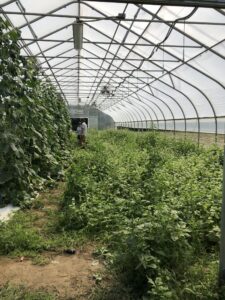
Buckwheat cover crop growing in half of the high tunnel (right), summer 2021. A cucumber trial was underway in the other half of the tunnel (left) 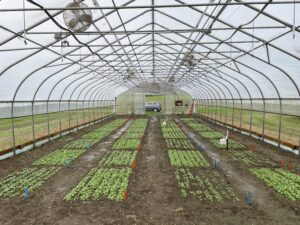
Full spinach germination/stand trial, October 22, 2021. The two left-hand beds received the buckwheat cover crop treatment.
4. Variety trial, winter 2022-23: In fall 2023, a spinach variety trial was set up at the UMass Crop & Livestock Research & Education Farm in South Deerfield, MA. This trial was managed by S. Scheufele of UMass.
- Treatments: 20 spinach varieties were chosen for evaluation, as recommended by Jim Correll of the University of Arkansas.
- Methods: All varieties were seeded on October 3, 2022, at a rate of 3 million seeds/A, with 4 replications of each variety in a randomized complete block design. Plots were 3'x3' and there was 1' between plots in-bed. Half of the tunnel was amended with bloodmeal to correct an N imbalance between the two halves of the tunnel resulting from the stand improvement trial over winter 2021-22. The trial was irrigated as needed using overhead irrigation.
- Data Collection and Analysis: Percent germination and percent post-emergence damping off were rated twice, 11 and 23 days after seeding. Plot vigor was rated as a percentage on November 14, January 20, and March 24. All varieties were harvested on November 14 and yield data was collected; additional harvests of some varieties were made on January 24 and March 2 but due to incomplete data we are presenting the November 14 yield data and the number of harvests for each variety over the course of the trial. All data were analyzed in SAS using a general linear model and means were compared using Tukey’s honestly significant difference test (P = 0.05).
Farmer Input: Input from growers on our project advisory board, from our UMass Extension Stakeholder Group, and also from other projects e.g. NE-SARE project LNE15-343 and the Frozen Ground Grower Network was solicited before developing these experimental questions and methods.
1. Variety Trial, winter 2020-21: Two varieties, 'Platypus' and 'Viroflay' had significantly lower germination rates than all other varieties in the trial (<15%) and were excluded from the dataset for the vigor and yield analyses. 'Crosstrek', 'Dallas', and 'Patton' were the most vigorous varieties on December 22 (before any varieties were harvested) and when vigor was averaged over the entire season.
Some notes about some varieties that stood out:
- 'Dallas' had the highest yield (0.921 lb/ft2), significantly higher than about half of the varieties trialed. 'Crosstrek' and 'Nembus' also had high yields, around 0.8 lbs/ft2.
- 'Auroch' and 'Bandicoot' had the lowest yields, both less than 0.5 lbs/ft2, and low vigor ratings, potentially caused by high rates of post-emergence damping off in both varieties.
- 'Nembus' was among the highest-yielding varieties, but had a middle-range plot vigor.
- 'Sculptur' had a high seasonal vigor rating, but a middle-range yield.
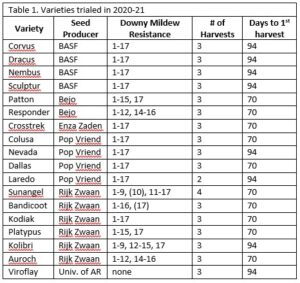
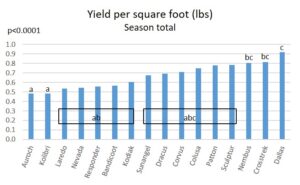
-
- Spinach variety trial, winter 2020-21: Yield per square foot. Statistical significance was determined using analysis of variance. Means were separated using Tukey's HSD at α-level 0.05. Varieties that share one or more letters are not significantly different from each other.
-
2. Improving plant stand, winter 2021-2022: The incorporation of cover crop residue had the largest effect (p = 0.0001) on germination, vigor, and yield, though variety was also significant (p = 0.0392). Crosstrek outperformed Kolibri in all measures. All treatments reached their maximum vigor (all above 80%) and yields (above 0.58 lbs/ft2) in the cover crop plots. The interaction of variety and cover crop was not significant (p=0.4550), meaning the effect of cover cropping was the same across the two varieties—cover crop residues led to increased germination, vigor, and yield in both varieties.
While we had hypothesized that incorporating fresh cover crop residues would stimulate activity of beneficial soil microbes and reduce damping off, we were surprised by the scale of the difference we saw in germination and growth between the two sides of the tunnel by mid-October. So, we started to think about what else could be contributing to these differences in growth.
The summer prior to the spinach trial, the bare ground half of the tunnel had received fertilizer and been planted to cucumbers, while the cover-cropped beds were bare or in buckwheat. No fertilizer was added to either side before the spinach trial was planted. On October 29, during the spinach trial, pre-sidedress nitrate tests showed that the soil nitrate in the cover-cropped beds was double that of the bare ground beds—32 compared to 15 ppm (see Figure 6). Since we did not control for soil nitrate content between the two sides of the tunnel, the effects we saw from cover crop incorporation may have simply been the effect of higher soil nitrate.
The significant trends that we saw from this study were:
- Incorporation of a buckwheat cover crop three weeks before seeding winter high tunnel spinach resulted in maximized germination, vigor, and yield, although it is unclear whether this was caused by the cover crop or soil nitrate content.
- The variety Crosstrek consistently out-performed Kolibri.
- Priming seed using the protocol we developed reduced both germination and yield of both varieties.
3. Variety trial, winter 2022-23:
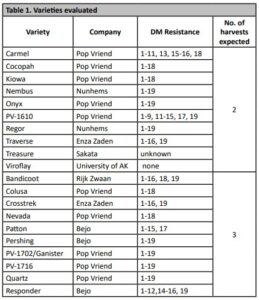
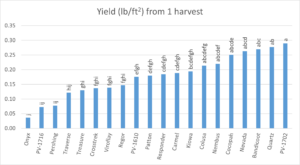
The varieties PV-1702, Quartz, Bandicoot, Nevada, Cocopah, Nembus, and Colusa had the highest and statistically equivalent yields at the first harvest (all above 0.2 lbs/ft2), and also had high germination rates (above 80%). Nembus and PV-1702 had the highest germination rates (95% and 92.5% respectively). All of those varieties, except for Cocopah and Nembus, were relatively fast-growing and could have been harvested 3 times over the course of the trial; Cocopah and Nembus could have been harvested only twice. Onyx, Pershing, and PV-1716 performed the worst of all the varieties; they had significantly lower germination than all other varieties. Onyx had the lowest yield of all varieties, but the yields of PV-1716, Pershing, and Traverse were not significantly different from Onyx.
Of these high-yielding varieties, most had a lighter green color and slightly oblong leaves that became deltoid (spade-like) after 1 or 2 harvests. Nembus and Quartz were darker green with rounder leaves.
Some varieties in the trial had more attractive re-growth than others. Because plots were harvested by clear cutting, the re-growth in some varieties had the tips of the leaves cut off. Other varieties with growing points deeper within the plant, had re-growth that did not show this cutting damage. Bandicoot, Colusa, Crosstrek, Patton, Pershing, and Responder all had re-growth that did not show cutting damage; the re-growth of all other varieties did show cutting damage by the 2nd harvest. After 2 harvests, Bandicoot was notably leggy and deltoid and may not have been marketable for some growers.
Spinach downy mildew did not develop in the tunnel, but Cladosporium leaf spot, a common fungal disease of spinach, did develop in late-winter. All plots of Crosstrek, Patton, Nevada, PV-1702, Colusa, and Bandicoot, and some plots of Carmel, Pershing, Responder, Quartz, and PV-1716 developed Cladosporium to some extent. Cladosporium resistance is currently not reported for commercially available varieties, but this is anecdotal evidence of varietal differences in susceptibility to Cladosporium warranting further research, as Cladosporium outbreaks are common and economically impactful in Northeast winter spinach production.
Variety trials, 2020-2023: Most spinach varieties are developed for production in California and Arizona, and varieties turn over quickly to meet the demands of those markets. We undertook four years of spinach variety trials to determine if new spinach varieties with broad spinach downy mildew resistance would be acceptable for production in Northeast winter tunnels – a very different climate from CA and AZ. Over the course of these trials, we have found that many of these varieties are acceptable and can produce high yields in Northeast winter tunnels. We did not trial the same set of varieties each year, but some varieties that were in the top 10 performers in more than one year are: Colusa, Nevada, Cocopah, Nembus, and Kiowa. Varieties that had high quality regrowth included but aren’t limited to: Crosstrek, Patton, Kiowa, Responder, and Colusa. Many of the varieties trialed are not available in seed catalogs in the Northeast but seed reps may be able to special order unlisted varieties from producers, especially if smaller-scale growers collaborate to meet minimum order requirements.
Improving plant stand: Variety selection can have a big impact on germination and therefore on yields. The effects of cover crop incorporation in this trial were clear – plots with buckwheat incorporated significantly outperformed those with no buckwheat – but the mechanism behind those effects are unknown. More research is needed to investigate whether the benefits we saw from buckwheat incorporation were from the addition of fresh organic matter to the soil, or whether they were from the nitrogen that the buckwheat contributed to the soil, or both.
Education
Workshops & Presentations: We held 5 virtual and in-person workshops/presentations to provide farmers and agricultural service providers with research results and recommendations regarding winter spinach production. These workshops/presentations included two presentations at conferences for farmers on spinach production and pests, a webinar detailing the spinach production case study project (see below) that we undertook as part of this SARE project, and one in-person research field day where spinach variety trial results were presented.
Case Studies: We also completed four in-depth spinach production case studies as part of this project. 4 farms signed on to be winter spinach production case-studies. These farms completed an extensive intake form with information about their winter spinach production practices. During the winter 2020-21 growing season, they each tracked their spinach labor, inputs, and yields for 1 spinach high tunnel, and were visited biweekly by G. Higgins of UMass. The information from these farms was used to create a narrative case study and an enterprise budget for each farm's winter spinach production. The case studies and enterprise budgets were presented by G. Higgins along with two of the case study growers (Danya Teitlbaum of Queens Greens and Ryan Karb of Many Hands Farm Corps) in a webinar (See Milestone #2 for webinar details).
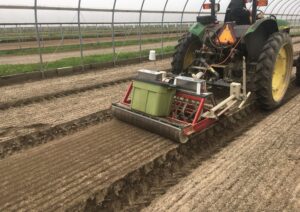
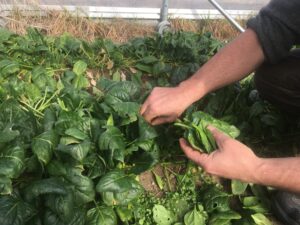
Downy mildew consultations and diagnostic support: As of May 18, 8 growers have reached out for support identifying the race of spinach downy mildew on their farms. We sent out samples from 6 of these farms, and 3 have been race typed so far.
Fact sheets & educational materials: The following fact sheets were written, posted online, and distributed through the Vegetable Notes newsletter (2800 subscribers).
- Fact Sheet: Spinach, Cladosporium Leaf Spot: Posted online, and published in the December 17, 2020 issue of Vegetable Notes
- Recommendations for Improving Winter High Tunnel Spinach Production: posted online
- Winter Spinach Production Enterprise Budgets: posted online
Newsletter articles:
- May 6, 2021: UMass Winter Spinach Variety Trials, 2020-21 Report
- March 17, 2022: Economics of Winter Spinach - Three Case Studies
- August 17, 2023: Winter High Tunnel Spinach Variety Trial, 2022-23
- September 14, 2023: Improving Germination and Stand in Winter
High Tunnel Spinach
Milestones
1,680 growers, agricultural service providers, and industry representatives learn about project activities, educational programs, and read newsletter articles on results of spinach variety trials and increase knowledge on current outbreaks of DM across the region, and learn about higher-yielding, disease-resistant varieties of lettuce and spinach. Of these, 250 growers and 25 ag service providers sign up to receive future notifications and information about ways to get involved including educational events and participation in the on-farm production survey.
250
25
2800
June 01, 2020
Completed
January 01, 2022
The following were distributed via the Vegetable Notes newsletter (3600 subscribers):
- 2020-21 Spinach Variety Trial results, May 6, 2021 issue
- Timely alerts of spinach downy mildew outbreaks over 2020-21 winter season
- Event listings for the January 28, 2021 Virtual Winter Greens Field Day (also advertised in other regional Extension newsletters), July 27, 2021 UMass Extension Field Day, and September 1, 2021 Economics of Winter Spinach webinar
- 2021-22 Spinach Germination Trial results
- 2022-23 Spinach Variety Trial results
Over the course of this project, our project website received 200 site hits, our stand-alone resources received 88 views, and the Vegetable Notes newsletter issues with articles on winter spinach production created as part of this project received 376 views.
12 growers signed up to adopt new spinach production practices and provide us with information on how the changes impacted their inputs and yields.
Attend or view webinars to increase knowledge on winter greens production methods, downy mildew biology and management through use of resistant varieties, and other common greens diseases and issues such as damping-off
300
50
249
35
February 26, 2023
Completed
February 26, 2023
We held 2 educational events and presented our findings from this project at 2 conferences, with a total of farmer 249 attendees, 35 agricultural service provider attendees, plus 153 subsequent views of our recorded webinar.
- January 28, 2021 Virtual Winter Greens Field Day: Attended by 60 farmers and 20 agricultural service providers. J. Correll (University of Arkansas) presented on US spinach production and spinach downy mildew, K. Clark (University of Arkansas) presented on epidemiology of spinach downy mildew, and G. Higgins (UMass) presented on the winter high tunnel spinach variety trials conducted as part of this SARE grant. Attendees increased their knowledge on the topics of spinach downy mildew and using resistant varieties to manage spinach downy mildew by 36.6% and 41.2%, respectively. Attendees reported that they were 78% likely to adopt our recommended spinach production and spinach downy mildew management practices. Recorded webinar has 153 views as of May 18, 2023: https://www.youtube.com/watch?v=IDtJO8lKiCg
- July 27, 2021 Research Field Day: UMass Crop & Livestock Research & Education Farm in South Deerfield, MA. 79 attendees. Results from the 2020-21 spinach variety trial and plans for the 2021-22 spinach germination and stand trial were presented. Attendees reported a 20% increase in knowledge about reducing damping off in high tunnel spinach. Attendees were 73% likely to adopt a damping off reduction practice.
- September 21, 2021 Economics of Winter Spinach webinar: Attended by 50 farmers and 15 agricultural service providers. G. Higgins (UMass) presented the results of the spinach production case study project along with two of the spinach growers who participated in the project - Ryan Karb of Many Hands Farm Corps and Danya Teitlbaum of Queen's Greens. Recorded webinar has 94 views as of May 18, 2023: https://www.youtube.com/watch?v=o_AaLBVjK6I
- February 3, 2022 Winter Greens Production & Pests, Mid-Atlantic Fruit & Vegetable Convention, Hershey, PA. Approximately 50 attendees. S. Scheufele (UMass) presented on winter greens production practices and the biology and management of pests in winter spinach.
- February 26, 2023 Winter Greens Production & Pests, SEMAP (Southeastern MA Agricultural Partnership) Agriculture & Food Conference. 10 attendees. S. Scheufele (UMass) presented on winter greens production practices and the biology and management of pests in winter spinach.
Attend on-farm workshops and field days and increase knowledge of downy mildew resistant-varieties and cost-effective production methods (results of regional high tunnel production survey)
200
30
144
15
July 31, 2021
Completed
July 27, 2021
50 farmers and 15 agricultural service providers attended our webinar on the Economics of Winter Spinach on September 1, 2021. This was a webinar instead of an in-person workshop due to COVID-19 restrictions. G. Higgins (UMass) presented the results of the spinach production case study project along with two of the spinach growers who participated in the project - Ryan Karb of Many Hands Farm Corps and Danya Teitlbaum of Queen's Greens. Recorded webinar has 94 views as of May 18, 2023: https://www.youtube.com/watch?v=o_AaLBVjK6I (94 plus 50 = 144)
Growers who attend educational programs and express interest in improving their winter greens production efficiency receive resources to help them implement and track changes including yield, and receive follow-up from project team in-person or by phone and email.
125
30
16
March 31, 2022
Completed
April 28, 2022
16 growers who attended educational programs and/or read about spinach production and spinach downy mildew management in Vegetable Notes expressed interest in improving their winter greens production efficiency and received resources regarding improving winter greens yields from us via email. 25 growers completed a survey on changes to their winter spinach production practices based on our publications.
Growers receive diagnostic support in the event of winter greens disease outbreaks on their farms. Samples are collected and shipped to collaborating labs for typing, and the results are communicated back to growers and shared with the Extension community to document emerging disease outbreaks.
20
30
6
March 31, 2022
Completed
January 01, 2023
As of January 2023, 8 Northeast growers have reached out for spinach downy mildew diagnostic support. Of those, 6 were sent out for race identification (the remaining 2 were not sent out for race identification because COVID travel restrictions prevented us from collecting samples from the farms). 2 were identified as the same novel strain and 1 as race 14. We have not received identification for 3 of the strains due to staff and resource shortages at our cooperating institution University of Arkansas.
Milestone activities and participation summary
Educational activities:
Participation summary:
Learning Outcomes
We verified changes in knowledge and practices regarding winter spinach production methods, spinach downy mildew pathology and management, spinach variety selection, and the economics of producing winter spinach. Learning outcome data was collected with event evaluations distributed after webinars and in-person events and with a survey sent to growers who expressed interest in changing their spinach production practices after interacting with our educational materials.
Performance Target Outcomes
Target #1
125
Northeast growers adopt at least one new best management practice in a total of 250 high tunnels. These farmers report an average yield of 0.5 lb/sq ft, and increased off-season revenue totaling $525,000 annually.
250 high-tunnels across the Northeast
Achieve yields of up to 0.50 pounds/sq ft, resulting in an increase in off-season revenue by $525,000.
212
One or several of the following (related to winter spinach production): Planted a downy mildew-resistant spinach variety; Planted multiple spinach varieties; Improved bed preparation to achieve more uniform beds; Changed the growing environment e.g. row cover, ventilation; Improved uniformity of irrigation; Increased price/lb; Improved soil pH with the goal of keeping pH above 6.5; Changed harvesting technique; Increased plant density; Used PSNTs to time sidedressing.
192 high tunnel growers reported increases in profitability
We conducted a survey of spinach outreach participants and, while our response rate was very low (10%) the results indicate that 85% of participants (212 growers) adopted at least one new or improved practice, and improved their yield. 77% (192 growers) reported that adopting these practices increased their profits. 38% (95 growers) reported achieving yields of approximately 0.5 lbs/sq ft, and 19% (47 growers) reported achieving yields above 0.5 lbs/sq ft. With the profit ranges provided in the survey, we measured that profits from winter spinach production for these growers combined increased by more than $148,442.
A high percentage of the growers involved in this project reported that the project had significant positive impact on their spinach production, yields, and profits. All of our educational activities were distributed or promoted through the UMass Extension Vegetable Notes newsletter, and so in Year 3 of this project, a survey was distributed three times to the 2800 newsletter subscribers. This survey targeted readers who had attended our educational events and interacted with our educational materials regarding winter greens production; the survey evaluated respondents’ scale of production, changes in practices, and the yield and profit impact of those changes.
85% of survey respondents reported that adopting our recommended production practices improved their yield, and 77% reported that it increased their profits. 57% reported that they achieved high yields of at least 0.5 lbs/sq ft. Those numbers indicate that we had a significant positive impact on the growers that did respond to our survey.
The number of farmers that we reached to verify outcomes was significantly lower than our target. In years 1 and 2, we couldn’t hold in-person events due to COVID-19 restrictions; we were able to reach a wide audience with our webinars but it is always harder to recruit survey respondents and project participants from online events. Only 26 commercial farmers fully completed the survey (10% response rate). We feel that during the pandemic, growers were extremely overtaxed and were inundated with surveys, resulting in a lower than usual response rate. However, with this data, in conjunction with our experience and data from routine evaluation at our outreach events supporting high levels of changes in knowledge and adoption of new practices, we feel it is justified to extrapolate this data to the 249 growers who attended our webinars and presentations live.
Additional Project Outcomes
As a result of our ongoing work in this area we were invited to participate in a national Specialty Crop Research Initiative (SCRI) project on spinach breeding for disease resistance.
One winter spinach producer in western Massachusetts reported a 122% yield increase (21,160 lbs) and 97% gross sales increase ($164,202) from winter spinach the season after working with us to develop an enterprise budget. As a result of understanding the economics of their winter spinach production, they felt confident investing more in winter spinach and increasing their plantings. We provided them with the tools to confirm that their spinach production enterprise was profitable and could be scaled up.
Another winter spinach producer from western Massachusetts reported that they installed permanent overhead irrigation in all of their high tunnels after working with us to evaluate their spinach production. This has saved them time in the winter and contributed to more even soil moisture. Working with us on this project also increased their awareness of the potential of overhead irrigation to spread foliar diseases including downy mildew, and they emphasized that they continue to plant several varieties of spinach every year to get maximum downy mildew resistance.
Practices to improve spinach germination is an area that warrants further research. The effects of incorporating green manure and the effects of higher soil nitrate content need to be parsed apart, and additional seed priming protocols could be tested. In regards to variety trials: we saw individual varieties perform very differently in different trial years, maybe due to seed lot variability. For future variety trials, seed germination trials should be completed in the lab prior to seeding in the high tunnel to determine the quality of the seed lot. In our variety trials, we also saw varietal differences in susceptibility to Cladopsorium leaf spot—this disease is common in winter high tunnel spinach and late-winter variety trials to evaluate susceptibility to Cladosporium would be useful for growers.
Information Products
- Spinach, Cladosporium Leaf Spot Fact Sheet
- Recommendations for Improving Winter High Tunnel Spinach Production
- 2021 UMass Field Day research report
- Winter Spinach Production Enterprise Budgets
- UMass Winter Spinach Variety Trials, 2020-21 Report
- Economics of Winter Spinach: Three Case Studies
- Winter High Tunnel Spinach Variety Trial, 2022-23
- Improving Germination and Stand in Winter High Tunnel Spinach
- Economics of Winter Spinach: Three Case Studies
- Virtual Winter Greens Field Day